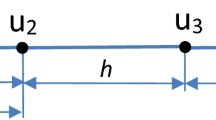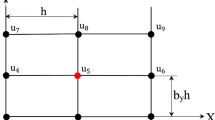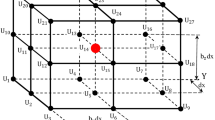Abstract
A new numerical approach for the time-dependent wave and heat equations as well as for the time-independent Poisson equation on irregular domains has been developed. Trivial Cartesian meshes and simple 9-point stencil equations with unknown coefficients are used for 2-D irregular domains. The calculation of the coefficients of the stencil equations is based on the minimization of the local truncation error of the stencil equations and yields the optimal order of accuracy. The treatment of the Dirichlet and Neumann boundary conditions in the new approach is related to the development of high-order boundary conditions with the stencils that include the same or a smaller number of grid points compared to that for the regular 9-point internal stencils. At similar 9-point stencils, the accuracy of the new approach is two orders higher than that for the linear finite elements. The numerical results for irregular domains in Part 2 of the paper also show that at the same number of degrees of freedom, the new approach is even much more accurate than the quadratic and cubic finite elements with much wider stencils. Similar to our recent results on regular domains, the order of the accuracy of the new approach for the Poisson equation on irregular domains with square Cartesian meshes is higher than that with rectangular Cartesian meshes. The new approach can be directly applied to other partial differential equations.







Similar content being viewed by others
References
Ahmadian, H., Friswell, M., Mottershead, J.: Minimization of the discretization error in mass and stiffness formulations by an inverse method. Int. J. Numer. Methods Eng. 41(2), 371–387 (1998)
Ainsworth, M., Wajid, H.A.: Optimally blended spectral-finite element scheme for wave propagation and nonstandard reduced integration. SIAM J. Numer. Anal. 48(1), 346–371 (2010)
Angel, J.B., Banks, J.W., Henshaw, W.D.: High-order upwind schemes for the wave equation on overlapping grids: Maxwell’s equations in second-order form. J. Comput. Phys. 352, 534–567 (2018)
Assêncio, D.C., Teran, J.M.: A second order virtual node algorithm for stokes flow problems with interfacial forces, discontinuous material properties and irregular domains. J. Comput. Phys. 250, 77–105 (2013)
Bedrossian, J., von Brecht, J.H., Zhu, S., Sifakis, E., Teran, J.M.: A second order virtual node method for elliptic problems with interfaces and irregular domains. J. Comput. Phys. 229(18), 6405–6426 (2010)
Bochkov, D., Gibou, F.: Solving poisson-type equations with robin boundary conditions on piecewise smooth interfaces. J. Comput. Phys. 376, 1156–1198 (2019)
Burman, E., Hansbo, P.: Fictitious domain finite element methods using cut elements: I. A stabilized lagrange multiplier method. Comput. Methods Appl. Mech. Eng. 199(41–44), 2680–2686 (2010)
Chen, L., Wei, H., Wen, M.: An interface-fitted mesh generator and virtual element methods for elliptic interface problems. J. Comput. Phys. 334, 327–348 (2017)
Colella, P., Graves, D.T., Keen, B.J., Modiano, D.: A cartesian grid embedded boundary method for hyperbolic conservation laws. J. Comput. Phys. 211(1), 347–366 (2006)
Crockett, R., Colella, P., Graves, D.: A cartesian grid embedded boundary method for solving the poisson and heat equations with discontinuous coefficients in three dimensions. J. Comput. Phys. 230(7), 2451–2469 (2011)
Dakin, G., Despres, B., Jaouen, S.: Inverse lax-wendroff boundary treatment for compressible lagrange-remap hydrodynamics on cartesian grids. J. Comput. Phys. 353, 228–257 (2018)
Dey, B., Idesman, A.: A new numerical approach to the solution of PDEs with optimal accuracy on irregular domains and Cartesian meshes. Part 2: numerical simulation and comparison with FEM. Arch. Appl. Mech. pp. 1–32 (2020)
Fries, T., Omerović, S., Schöllhammer, D., Steidl, J.: Higher-order meshing of implicit geometries—Part I: Integration and interpolation in cut elements. Comput. Methods Appl. Mech. Eng. 313, 759–784 (2017)
Guddati, M.N., Yue, B.: Modified integration rules for reducing dispersion error in finite element method. Comput. Methods Appl. Mech. Eng. 193, 275–287 (2004)
Gyrya, V., Lipnikov, K.: M-adaptation method for acoustic wave equation on square meshes. J. Comput. Acoust. 20(1250022–1), 23 (2012)
He, Z.C., Cheng, A.G., Zhang, G.Y., Zhong, Z.H., Liu, G.R.: Dispersion error reduction for acoustic problems using the edge-based smoothed finite element method (es-fem). Int. J. Numer. Methods Eng. 86(11), 1322–1338 (2011)
Hellrung, J.L., Wang, L., Sifakis, E., Teran, J.M.: A second order virtual node method for elliptic problems with interfaces and irregular domains in three dimensions. J. Comput. Phys. 231(4), 2015–2048 (2012)
Hoang, T., Verhoosel, C.V., Auricchio, F., van Brummelen, E.H., Reali, A.: Mixed isogeometric finite cell methods for the stokes problem. Comput. Methods Appl. Mech. Eng. 316, 400–423 (2017)
Hosseinverdi, S., Fasel, H.F.: An efficient, high-order method for solving poisson equation for immersed boundaries: combination of compact difference and multiscale multigrid methods. J. Comput. Phys. 374, 912–940 (2018)
Idesman, A.: Optimal reduction of numerical dispersion for wave propagation problems. Part 1: Application to 1-d isogeometric elements. Comput. Methods Appl. Mech. Eng. 317, 970–992 (2017)
Idesman, A.: The use of the local truncation error to improve arbitrary-order finite elements for the linear wave and heat equations. Comput. Methods Appl. Mech. Eng. 334, 268–312 (2018)
Idesman, A., Dey, B.: Optimal reduction of numerical dispersion for wave propagation problems. Part 2: Application to 2-d isogeometric elements. Comput. Methods Appl. Mech. Eng. 321, 235–268 (2017)
Idesman, A., Dey, B.: The use of the local truncation error for the increase in accuracy of the linear finite elements for heat transfer problems. Comput. Methods Appl. Mech. Eng. 319, 52–82 (2017)
Idesman, A., Dey, B.: A new 3-D numerical approach to the solution of PDEs with optimal accuracy on irregular domains and Cartesian meshes. Comput. Methods Appl. Mech. Eng. 354, 568–592 (2019)
Idesman, A., Dey, B.: Accurate numerical solutions of 2-d elastodynamics problems using compact high-order stencils. Comput. Struct. 229, 1–18 (2020)
Idesman, A., Dey, B.: Accurate numerical solutions of 2-d elastodynamics problems using compact high-order stencils. Comput. Struct. 229, 106160 (2020)
Idesman, A., Dey, B.: Compact high-order stencils with optimal accuracy for numerical solutions of 2-D time-independent elasticity equations. Comput. Methods Appl. Mech. Eng. 360, 112699 (2020)
Idesman, A., Dey, B.: New 25-point stencils with optimal accuracy for 2-d heat transfer problems. Comparison with the quadratic isogeometric elements. J. Comput. Phys. 418, 109640 (2020)
Idesman, A., Dey, B.: A new numerical approach to the solution of the 2-D Helmholtz equation with optimal accuracy on irregular domains and Cartesian meshes. Comput. Mech. 65, 1189–1204 (2020)
Idesman, A., Dey, B.: The treatment of the Neumann boundary conditions for a new numerical approach to the solution of PDEs with optimal accuracy on irregular domains and Cartesian meshes. Comput. Methods Appl. Mech. Eng. 365, 112985 (2020)
Idesman, A., Pham, D.: Accurate finite element modeling of acoustic waves. Comput. Phys. Commun. 185, 2034–2045 (2014)
Idesman, A., Pham, D.: Finite element modeling of linear elastodynamics problems with explicit time-integration methods and linear elements with the reduced dispersion error. Comput. Methods Appl. Mech. Eng. 271, 86–108 (2014)
Idesman, A., Schmidt, M., Foley, J.R.: Accurate finite element modeling of linear elastodynamics problems with the reduced dispersion error. Comput. Mech. 47, 555–572 (2011)
Johansen, H., Colella, P.: A cartesian grid embedded boundary method for poisson’s equation on irregular domains. J. Comput. Phys. 147(1), 60–85 (1998)
Jomaa, Z., Macaskill, C.: The embedded finite difference method for the poisson equation in a domain with an irregular boundary and dirichlet boundary conditions. J. Comput. Phys. 202(2), 488–506 (2005)
Jomaa, Z., Macaskill, C.: The shortley-weller embedded finite-difference method for the 3d poisson equation with mixed boundary conditions. J. Comput. Phys. 229(10), 3675–3690 (2010)
Kreiss, H.O., Petersson, N.A.: A second order accurate embedded boundary method for the wave equation with dirichlet data. SIAM J. Sci. Comput. 27(4), 1141–1167 (2006)
Kreiss, H.O., Petersson, N.A., Ystrom, J.: Difference approximations of the neumann problem for the second order wave equation. SIAM J. Numer. Anal. 42(3), 1292–1323 (2004)
Kreisst, H.O., Petersson, N.A.: An embedded boundary method for the wave equation with discontinuous coefficients. SIAM J. Sci. Comput. 28(6), 2054–2074 (2006)
Krenk, S.: Dispersion-corrected explicit integration of the wave equation. Comput. Methods Appl. Mech. Eng. 191, 975–987 (2001)
Main, A., Scovazzi, G.: The shifted boundary method for embedded domain computations. Part I: Poisson and stokes problems. J. Comput. Phys. 372, 972–995 (2018)
Marfurt, K.J.: Accuracy of finite difference and finite element modeling of the scalar and elastic wave equation. Geophysics 49, 533–549 (1984)
Mattsson, K., Almquist, M.: A high-order accurate embedded boundary method for first order hyperbolic equations. J. Comput. Phys. 334, 255–279 (2017)
May, S., Berger, M.: An explicit implicit scheme for cut cells in embedded boundary meshes. J. Sci. Comput. 71(3), 919–943 (2017)
McCorquodale, P., Colella, P., Johansen, H.: A cartesian grid embedded boundary method for the heat equation on irregular domains. J. Comput. Phys. 173(2), 620–635 (2001)
Mullen, R., Belytschko, T.: Dispersion analysis of finite element semidiscretizations of the two-dimensional wave equation. Int. J. Numer. Methods Eng. 18, 11–29 (1982)
Puzyrev, V., Deng, Q., Calo, V.: Dispersion-optimized quadrature rules for isogeometric analysis: Modified inner products, their dispersion properties, and optimally blended schemes. Comput. Methods Appl. Mech. Eng. 320, 421–443 (2017)
Rank, E., Kollmannsberger, S., Sorger, C., Duster, A.: Shell finite cell method: a high order fictitious domain approach for thin-walled structures. Comput. Methods Appl. Mech. Eng. 200(45–46), 3200–3209 (2011)
Rank, E., Ruess, M., Kollmannsberger, S., Schillinger, D., Duster, A.: Geometric modeling, isogeometric analysis and the finite cell method. Comput. Methods Appl. Mech. Eng. 249–252, 104–115 (2012)
Schwartz, P., Barad, M., Colella, P., Ligocki, T.: A cartesian grid embedded boundary method for the heat equation and poisson’s equation in three dimensions. J. Comput. Phys. 211(2), 531–550 (2006)
Seriani, G., Oliveira, S.P.: Optimal blended spectral-element operators for acoustic wave modeling. Geophysics 72(5), 95–106 (2007)
Singh, K., Williams, J.: A parallel fictitious domain multigrid preconditioner for the solution of poisson’s equation in complex geometries. Comput. Methods Appl. Mech. Eng. 194(45–47), 4845–4860 (2005)
Song, T., Main, A., Scovazzi, G., Ricchiuto, M.: The shifted boundary method for hyperbolic systems: embedded domain computations of linear waves and shallow water flows. J. Comput. Phys. 369, 45–79 (2018)
Uddin, H., Kramer, R., Pantano, C.: A cartesian-based embedded geometry technique with adaptive high-order finite differences for compressible flow around complex geometries. J. Comput. Phys. 262, 379–407 (2014)
Vos, P., van Loon, R., Sherwin, S.: A comparison of fictitious domain methods appropriate for spectral/hp element discretisations. Comput. Methods Appl. Mech. Eng. 197(25–28), 2275–2289 (2008)
Wang, D., Liu, W., Zhang, H.: Novel higher order mass matrices for isogeometric structural vibration analysis. Comput. Methods Appl. Mech. Eng. 260, 92–108 (2013)
Wang, D., Liu, W., Zhang, H.: Superconvergent isogeometric free vibration analysis of euler-bernoulli beams and kirchhoff plates with new higher order mass matrices. Comput. Methods Appl. Mech. Eng. 286, 230–267 (2015)
Wang, D., Liang, Q., Wu, J.: A quadrature-based superconvergent isogeometric frequency analysis with macro-integration cells and quadratic splines. Comput. Methods Appl. Mech. Eng. 320, 712–744 (2017)
Yue, B., Guddati, M.N.: Dispersion-reducing finite elements for transient acoustics. J. Acoust. Soc. Am. 118(4), 2132–2141 (2005)
Zhao, S., Wei, G.W.: Matched interface and boundary (mib) for the implementation of boundary conditions in high-order central finite differences. Int. J. Numer. Methods Eng. 77(12), 1690–1730 (2009)
Acknowledgements
The research has been supported in part by the Air Force Office of Scientific Research (contract FA9550-16-1-0177), by NSF (Grant CMMI-1935452) and by Texas Tech University.
Author information
Authors and Affiliations
Corresponding author
Ethics declarations
Conflict of interest
There is no conflict of interest.
Additional information
Publisher's Note
Springer Nature remains neutral with regard to jurisdictional claims in published maps and institutional affiliations.
Electronic supplementary material
Below is the link to the electronic supplementary material.
Appendix A: The coefficients \(b_p\) used in Eqs. (38), (56), (63) and (69)
Appendix A: The coefficients \(b_p\) used in Eqs. (38), (56), (63) and (69)
The first five coefficients \(b_i\) (\(i=1,2,\ldots ,5\)) used in Eqs. (38), (56), (63) and (69) are presented below. All coefficients \(b_i\) used in these formulas are given in the attached file ’b-coeff.pdf’
Equation (38):
Equation (56):
Equation (63):
Equation (69):
Rights and permissions
About this article
Cite this article
Idesman, A. A new numerical approach to the solution of PDEs with optimal accuracy on irregular domains and Cartesian meshes—Part 1: the derivations for the wave, heat and Poisson equations in the 1-D and 2-D cases. Arch Appl Mech 90, 2621–2648 (2020). https://doi.org/10.1007/s00419-020-01744-w
Published:
Issue Date:
DOI: https://doi.org/10.1007/s00419-020-01744-w




